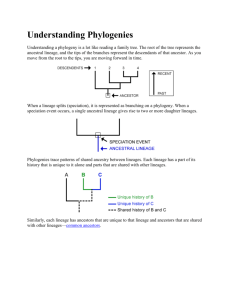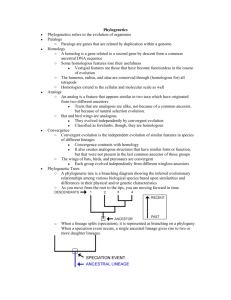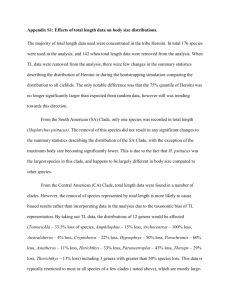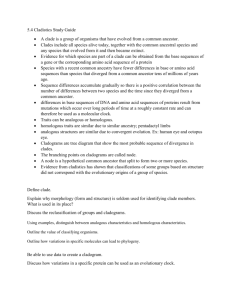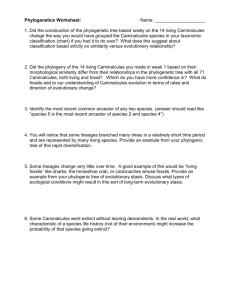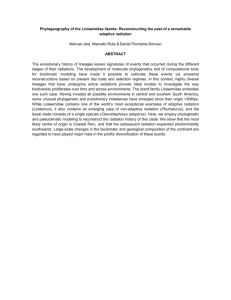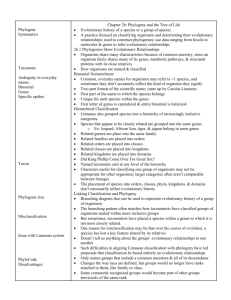Understanding phylogenies
advertisement
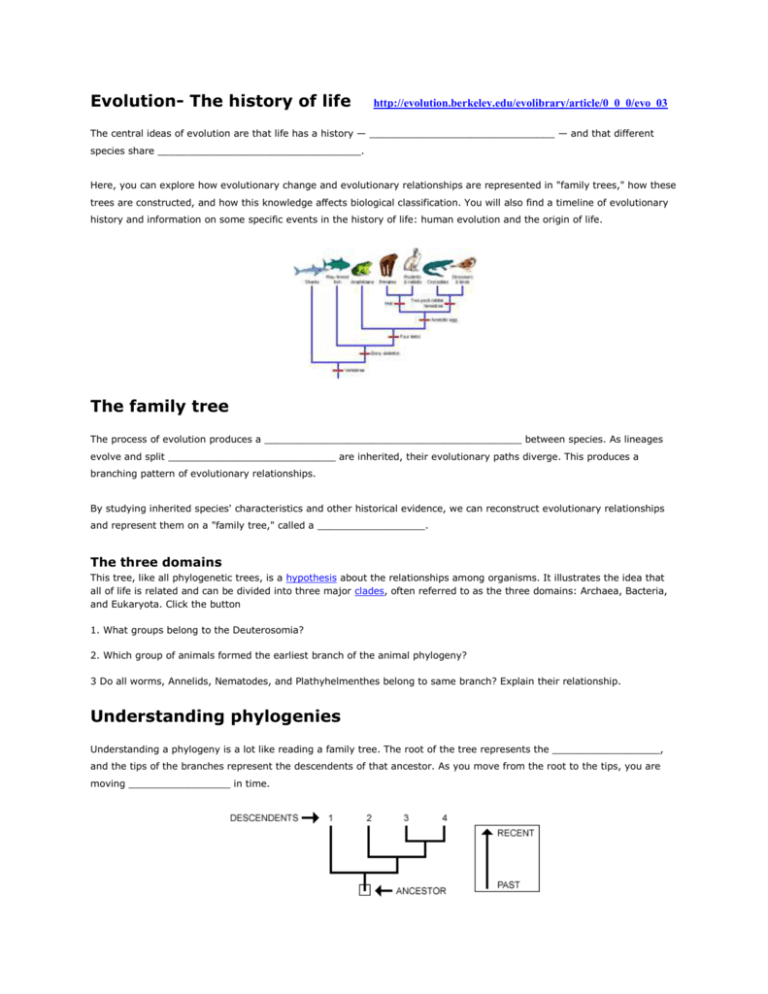
Evolution- The history of life http://evolution.berkeley.edu/evolibrary/article/0_0_0/evo_03 The central ideas of evolution are that life has a history — _______________________________ — and that different species share __________________________________. Here, you can explore how evolutionary change and evolutionary relationships are represented in "family trees," how these trees are constructed, and how this knowledge affects biological classification. You will also find a timeline of evolutionary history and information on some specific events in the history of life: human evolution and the origin of life. The family tree The process of evolution produces a ___________________________________________ between species. As lineages evolve and split ____________________________ are inherited, their evolutionary paths diverge. This produces a branching pattern of evolutionary relationships. By studying inherited species' characteristics and other historical evidence, we can reconstruct evolutionary relationships and represent them on a "family tree," called a __________________. The three domains This tree, like all phylogenetic trees, is a hypothesis about the relationships among organisms. It illustrates the idea that all of life is related and can be divided into three major clades, often referred to as the three domains: Archaea, Bacteria, and Eukaryota. Click the button 1. What groups belong to the Deuterosomia? 2. Which group of animals formed the earliest branch of the animal phylogeny? 3 Do all worms, Annelids, Nematodes, and Plathyhelmenthes belong to same branch? Explain their relationship. Understanding phylogenies Understanding a phylogeny is a lot like reading a family tree. The root of the tree represents the __________________, and the tips of the branches represent the descendents of that ancestor. As you move from the root to the tips, you are moving _________________ in time. When a lineage splits (speciation), it is represented as ______________________________ on a phylogeny. When a speciation event occurs, a single ancestral lineage gives rise to two or more daughter lineages. Phylogenies trace patterns of shared ancestry between lineages. Each lineage has a part of its history that is ___________________________ to it alone and parts that are shared with other lineages. Similarly, each lineage has __________________________that are unique to that lineage and ancestors that are shared with other lineages — common ancestors. Understanding phylogenies (2 of 2) A _______________________ is a grouping that includes a common ancestor and all the descendents (living and extinct) of that ancestor. Using a ____________________________, it is easy to tell if a group of lineages forms a clade. Imagine clipping a single branch off the phylogeny — all of the organisms _____________________________________________. Clades are nested within one another — they form a ________________________________. A clade may include many thousands of species or just a few. Some examples of clades at different levels are marked on the phylogenies below. Notice how clades are nested within larger clades. So far, we've said that the tips of a phylogeny represent descendent lineages. Depending on how many branches of the tree you are including however, the descendents at the tips might be different populations of a species, different species, or different clades, each composed of many _______________________. Trees, not ladders Several times in the past, biologists have committed themselves to the erroneous idea that life can be organized on a __________________________ of lower to higher organisms. Similarly, it's easy to misinterpret phylogenies as implying that some organisms are more ___________________ than others; however, phylogenies don't imply this at all. In this highly simplified phylogeny, a speciation event occurred resulting in two lineages. One led to the _________________of today; the other led to the ____________________________________________. Since that speciation event, both lineages have had an equal amount of time to evolve. So, although mosses branch off early on the tree of life and share many features with the ancestor of all land plants, living moss species are not ancestral to other land plants. Nor are they more primitive. Mosses are the cousins of other land plants. So when reading a phylogeny, it is important to keep three things in mind: Biologists often put the clade they are most interested in (whether that is bats, bedbugs, or bacteria) on the right side of the phylogeny. Misconceptions about humans The points described above cause the most problems when it comes to human evolution. The phylogeny of living species most closely related to us looks like this: It is important to remember that: 1. Humans did not evolve from chimpanzees. Humans and chimpanzees are evolutionary cousins and share a_____________________________ _______________________________________________________ 2. Humans are not ___________________________________than other living lineages. Since our lineages split, humans and chimpanzees have each evolved traits unique to their own lineages. Building the tree Like family trees, phylogenetic trees represent _________________________________. However, while families have the opportunity to record their own history as it happens, evolutionary lineages do not- ____________________ in nature do not come with pieces of paper showing their family histories. Instead, biologists must reconstruct those histories by ________________________________________________________, which they use to form a hypothesis about how the organisms are related — a phylogeny. To build a phylogenetic tree such as the one to the right, biologists collect data about the characters of each organism they are interested in. Characters are __________________________ that can be compared across organisms, such as 1._____________________, 2. _____________________________, 3.___________________________. In order to construct the vertebrate phylogeny, we begin by examining representatives of each lineage to learn about their basic morphology, whether or not the lineage has vertebrae, a bony skeleton, four limbs, an amniotic egg, etc. Using shared derived characters Our goal is to find evidence __________________________________________________ less and less inclusive clades. Specifically, we are interested in shared ___________________ characters. A shared character is one that two lineages have in common, and a derived character is one that evolved in the lineage leading up to a clade and that sets members of that clade apart from other individuals. Shared derived characters can be used to group organisms into ______________________. For example, amphibians, turtles, lizards, snakes, crocodiles, birds and mammals all have, or historically had, four limbs. If you look at a modern snake you might not see obvious limbs, but fossils show that ancient snakes did have limbs, and some modern snakes actually do retain rudimentary limbs. Four limbs is a shared derived character inherited from a common ancestor that helps set apart this particular clade of vertebrates. However, the presence of four limbs is not useful for determining relationships within the clade in green above, since all lineages in the clade have that character. To determine the relationships in that clade, we would need to examine other characters that vary across the lineages in the clade. Homologies and analogies Since a phylogenetic tree is a hypothesis about evolutionary relationships, we want to use characters that are reliable indicators of common ancestry to build that tree. We use ___________________ characters — characters in different organisms that are similar because they were inherited from a common ancestor that also had that character. An example of homologous characters is the four limbs of _______________________. Birds, bats, mice, and crocodiles all have four limbs. Sharks and bony fish do not. The ancestor of tetrapods evolved four limbs, and its descendents have inherited that feature — so the presence of four limbs is a __________________________. Not all characters are homologies. For example, birds and bats both have _______________, while mice and crocodiles do not. Does that mean that birds and bats are more closely related to one another than to mice and crocodiles? No. When we examine bird wings and bat wings closely, we see that there are some major differences. Bat wings consist of flaps of skin stretched between the bones of the fingers and arm. Bird wings consist of feathers extending all along the arm. These structural dissimilarities suggest that bird wings and bat wings were not inherited from a common ancestor with wings. This idea is illustrated by the phylogeny below, which is based on a large number of other characters. Bird and bat wings are ___________________________— that is, they have separate evolutionary origins, but are superficially similar because they evolved to serve the same function. Analogies are the result of ________________________________. Interestingly, though bird and bat wings are analogous as wings, as forelimbs they are homologous. Birds and bats did not inherit wings from a common ancestor with wings, but they did inherit forelimbs from a common ancestor with forelimbs. Using the tree for classification Biologists use phylogenetic trees for many purposes, including: 1. 2. 3. Using phylogenies as a basis for classification is a relatively new development in biology. Most of us are accustomed to the _________________________________________________ that assigns every organism a kingdom, phylum, class, order, family, genus, and species, which, among other possibilities, has the handy mnemonic King Philip Came Over For Good Soup. This system was created long before scientists understood that organisms evolved. Because the Linnaean system is not based on _______________________________, most biologists are switching to a classification system that reflects the organisms' evolutionary history. This phylogenetic classification system names only ________________ — groups of organisms that are all descended from a common ancestor. As an example, we can look more closely at reptiles and birds. Under a system of phylogenetic classification, we could name any clade on this tree. For example, the Testudines, Squamata, Archosauria, and Crocodylomorpha all form clades. However, the ______________________ do not form a clade, as shown in the cladogram. That means that either "reptile" is not a valid phylogenetic grouping or we have to start thinking of birds as reptiles. Another cool thing about _________________________________ is that it means that dinosaurs are not entirely extinct. Birds are, in fact, dinosaurs (part of the clade Dinosauria). It's pretty neat to think that you could learn something about T. rex by studying birds! Adding time to the tree If you wanted to squeeze the _____________________________________of the history of life on Earth into a single minute, you would have to wait about ______________________________ for multicellular life to evolve, another four seconds for vertebrates to invade the land, and another four seconds for flowers to evolve — and only in the last ______________________________ would "modern" humans arise. Biologists often represent time on phylogenies by drawing the branch lengths ____________________________ that has passed since that lineage arose. If the tree of life were drawn in this way, it would have a very long trunk indeed before it reached the first plant and animal branches. The following phylogeny represents vertebrate evolution — just a small clade on the tree of life. The lengths of the branches have been adjusted to show when lineages split and went extinct. How we know what happened when Life began __________________________________, and insects diversified 290 million years ago, but the human and chimpanzee lineages diverged only ___________________________years ago. How have scientists figured out the dates of long past evolutionary events? Here are some of the methods and evidence that scientists use to put dates on events: 1. Radiometric dating relies on ________________________________________________________ to allow scientists to date rocks and materials directly. 2. Stratigraphy provides a sequence of events from which relative dates can be __________________. 3. Molecular clocks allow scientists to use the amount of ______________________________ between organisms to extrapolate backwards to estimate dates. Important events in the history of life (text-only version) View the Graphical timeline A timeline can provide additional information about life's history not visible on an evolutionary tree. These include major geologic events, climate changes, radiation of organisms into new habitats, changes in ecosystems, changes in continental positions, and major extinctions. Explore the timeline below to view some of the major events in life's history. Years ago Event 130,000 Anatomically modern humans evolve. Seventy thousand years later, their descendents create cave paintings — early expressions of consciousness. 4 million In Africa, an early hominid, affectionately named "Lucy" by scientists, lives. The ice ages begin, and many large mammals go extinct. 65 million A massive asteroid hits the Yucatan Peninsula, and ammonites and non-avian dinosaurs go extinct. Birds and mammals are among the survivors. 130 million As the continents drift toward their present positions, the earliest flowers evolve, and dinosaurs dominate the landscape. In the sea, bony fish diversify. 225 million Dinosaurs and mammals evolve. Pangea has begun to break apart. 248 million Over 90% of marine life and 70% of terrestrial life go extinct during the Earth's largest mass extinction. Ammonites are among the survivors. 250 million The supercontinent called Pangea forms. Conifer-like forests, reptiles, and synapsids (the ancestors of mammals) are common. 360 million Four-limbed vertebrates move onto the land as seed plants and large forests appear. The Earth's oceans support vast reef systems. 420 million Land plants evolve, drastically changing Earth's landscape and creating new habitats. 450 million Arthropods move onto the land. Their descendants evolve into scorpions, spiders, mites, and millipedes. 500 million Fish-like vertebrates evolve. Invertebrates, such as trilobites, crinoids, brachiopids, and cephalopods, are common in the oceans. 555 million Multi-cellular marine organisms are common. The diverse assortment of life includes bizarre-looking animals like Wiwaxia. 3.5 billion Unicellular life evolves. Photosynthetic bacteria begin to release oxygen into the atmosphere. 3.8 billion Replicating molecules (the precursors of DNA) form. 4.6 billion The Earth forms and is bombarded by meteorites and comets.
